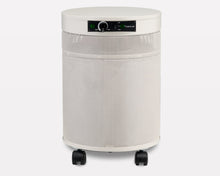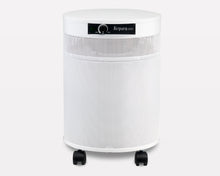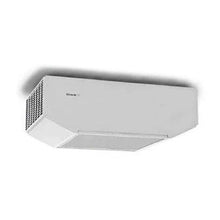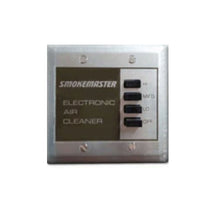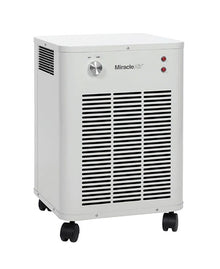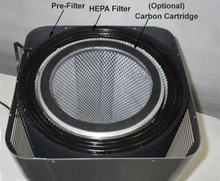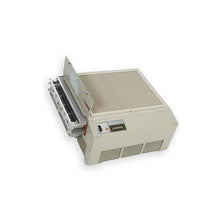Beyond the Man Cave: The Ultimate Guide to Wife-Approved Cigar Room Ventilation

By the Experts at Commercial Air Purifiers | Published: October 14, 2025
There’s a unique ritual to enjoying a fine cigar. It’s a moment of pause, a chance to reflect, savoring the complex aromas and the quiet cloud of smoke. But as that smoke dissipates, a common concern often rises in its place: the lingering smell that clings to furniture, seeps under doors, and permeates the rest of your home. The challenge isn't just about enjoying your hobby; it's about doing so respectfully and ensuring the air in your shared living space remains clean and fresh for everyone. Achieving a truly “wife-approved” cigar room isn’t about masking odors—it’s about eliminating them at the source with a smart, scientific approach to ventilation and purification.
This guide is for the discerning cigar enthusiast who values both their passion and domestic harmony. We’ll move beyond ineffective scented candles and cracked windows to explore a comprehensive strategy for clean air. Forget the temporary fixes. We’re here to provide the definitive blueprint for creating a sophisticated, odor-free cigar lounge that keeps the smoke, smell, and harmful pollutants contained, leaving the rest of your home completely untouched.
The Lingering Problem: Why Cigar Smoke is So Hard to Eliminate
If you’ve ever tried to air out a room after a cigar, you know that the smoke is uniquely stubborn. This isn't your imagination. The complexity of cigar smoke is precisely why standard household solutions fail. When a cigar is lit, it releases a cocktail of thousands of chemical compounds into the air, creating a three-pronged assault on your indoor air quality.
First, there are the visible particles. This is the soot and ash you see, technically known as particulate matter (PM). The most dangerous of these are the fine particles, or PM2.5, which are so small they can penetrate deep into the lungs and even enter the bloodstream. According to the U.S. Centers for Disease Control and Prevention (CDC), secondhand smoke contains over 7,000 chemicals, of which hundreds are toxic and about 70 can cause cancer. These particles are the immediate irritants.
Second, and perhaps more challenging, are the gases and Volatile Organic Compounds (VOCs). These are the invisible components responsible for the signature, pervasive aroma of a cigar. Compounds like benzene, formaldehyde, and acrolein are released, and because they are gases, they aren't easily trapped by simple filters. They float freely, embedding themselves into any porous surface they can find—carpets, drapes, upholstery, and even drywall. This is why the smell returns long after the visible smoke is gone.
Finally, there’s the often-overlooked issue of thirdhand smoke. As described by the Mayo Clinic Health System, this is the toxic residue that remains after the smoke has cleared. These chemicals cling to surfaces, age over time, and can react with other common indoor pollutants to create new, harmful compounds. This sticky, invisible residue is a primary source of the "stale smoke" smell and poses a lingering health risk. Understanding this trifecta of pollutants—particles, gases, and residue—is the first step to defeating it. An open window simply can’t compete with this level of chemical complexity.
The Two Pillars of Clean Air: Ventilation and Purification
To effectively manage cigar smoke, you need a two-part strategy that addresses the problem from different angles: active ventilation and targeted purification. Many people think these are interchangeable, but they serve distinct and complementary functions. Relying on just one is often a recipe for failure and lingering odors.
The Role of Exhaust Fans (Active Ventilation)
Active ventilation, typically achieved with an exhaust fan, is your first line of defense. The principle is straightforward: move large volumes of contaminated air from inside the room to the outside. A properly sized exhaust fan creates negative pressure, pulling the smoke-filled air out before it has a chance to settle or escape into other parts of the house.
This method is incredibly effective at dealing with the immediate, dense clouds of smoke produced while you’re actively enjoying a cigar. It’s a brute-force approach that tackles the volume of the problem head-on. However, its limitations become apparent once the cigar is out. Exhaust fans are less effective at capturing the microscopic particles and gaseous VOCs that remain suspended in the air. Furthermore, they can be inefficient, as they constantly expel the heated or cooled air you’ve paid to condition, leading to higher energy bills. While an essential tool, an exhaust fan alone won't pass the critical “next-day smell test.”
The Power of Air Purification (Targeted Filtration)
This is where air purification comes in. Unlike an exhaust fan that just moves air, a high-quality air purifier pulls air through a sophisticated filtration system to trap and remove contaminants. For the complex challenge of cigar smoke, a generic air purifier won't suffice. You need a system equipped with two specific technologies working in tandem.
First is a High-Efficiency Particulate Air (HEPA) filter. This is the global standard for capturing solid particles. A true HEPA filter is certified to capture 99.97% of airborne particles down to 0.3 microns in size. This includes the PM2.5 from cigar smoke, dust, pollen, and other allergens, effectively scrubbing the air of its physical irritants.
The second, and arguably more critical component for odor control, is a substantial activated carbon filter. Activated carbon works through a process called adsorption, where odor molecules, VOCs, and other gaseous pollutants chemically bond to the vast surface area of the carbon. Think of it not as a net, but as a powerful chemical magnet for smells. A sprinkle of carbon dust found in many consumer-grade purifiers is quickly overwhelmed by cigar smoke. For true effectiveness, a system needs a deep bed of activated carbon, often weighing several pounds, to provide enough capacity and contact time to neutralize the relentless onslaught of VOCs from a cigar.
The most effective strategy combines both: using an exhaust fan during the smoking session to clear the bulk of the smoke, and a powerful air purifier running continuously to capture what remains.
Not All Purifiers Are Created Equal: Key Metrics for Cigar Smoke
When selecting an air purifier for a cigar room, marketing jargon can be confusing. To cut through the noise, you must focus on two fundamental performance metrics: CFM and the quantity of activated carbon. These numbers will tell you more about a unit's true capability than any flashy sales pitch.
Understanding CFM (Cubic Feet per Minute)
CFM, or Cubic Feet per Minute, is the measure of airflow a purifier can handle. It tells you exactly how much air the machine can move and clean in a given time. For a room dedicated to cigar smoking, a high CFM rating is non-negotiable. The goal is to achieve a high number of Air Changes per Hour (ACH), which indicates how many times the purifier can clean the entire volume of air in the room every hour. For a typical bedroom, 2-4 ACH might be fine. For a cigar room, we recommend a minimum of 8-10 ACH to keep up with the constant introduction of pollutants.
To calculate your required CFM, use this simple formula:
-
Calculate your room’s volume in cubic feet: (Length x Width x Height).
-
Multiply that volume by your desired ACH (use 10 for a cigar room).
-
Divide the result by 60 (the number of minutes in an hour).
Example: A 15-foot by 12-foot room with an 8-foot ceiling has a volume of 1,440 cubic feet.
(1,440 cubic feet×10 ACH)/60 minutes=240 CFM
Therefore, you would need a purifier rated for at least 240 CFM on its operational setting (not just its maximum). It is always better to oversize your unit and run it on a lower, quieter setting than to have an undersized unit struggling at max power.
Why the Amount of Activated Carbon Matters More Than You Think
As we mentioned, activated carbon is the key to odor elimination. The U.S. Environmental Protection Agency (EPA) notes that activated carbon filters are effective at removing certain gases, but their capacity is critical. The amount of carbon in a filter, typically measured in pounds, determines two things: how much odor it can adsorb and how long it will last before becoming saturated.
A filter with just an ounce or two of carbon will be overwhelmed by a single cigar, rendering it useless. The VOCs will simply pass right through. A robust air purification system designed for heavy odors will contain a carbon bed of 15 pounds or more. This massive surface area ensures that there is sufficient capacity to adsorb the high concentration of gases from cigar smoke and continue working effectively for months before a filter change is needed. When evaluating a unit, always ask about the weight of the activated carbon. It is the single best indicator of a purifier's ability to combat severe odors.
Setting Up Your Space for Success: A Holistic Approach
The best air purification system in the world will perform even better when supported by a smart room setup. Creating a contained environment prevents smoke and odors from escaping and makes the job of your ventilation and purification equipment much easier.
Consider implementing a few of these strategies. First, seal the room as effectively as possible. Use weather stripping around the door frame and install a door sweep at the bottom to close any gaps. This simple step can dramatically reduce smoke leakage into hallways and adjacent rooms.
Second, pay attention to the surfaces in your room. Porous materials like thick carpets, heavy fabric curtains, and cloth-upholstered furniture are odor magnets. They readily absorb the VOCs and thirdhand smoke residue, making it nearly impossible to ever fully remove the smell. Whenever possible, opt for hard, non-porous surfaces. Hardwood or tile floors, leather or vinyl furniture, and simple blinds are far easier to wipe down and keep clean.
Finally, think about placement. Your exhaust fan should be placed as close to your primary smoking area as possible to capture smoke at the source. Your air purifier, on the other hand, should generally be placed across the room to promote better air circulation, pulling the contaminated air towards it before it has a chance to stagnate.
Building Your "Wife-Approved" Ventilation Strategy
Now, let's bring it all together into a simple, actionable plan that guarantees clean air and domestic peace.
-
Contain the Environment: Before you even light up, ensure your room is properly sealed. Choose surfaces that are easy to clean and won't trap odors. This foundational step contains the problem to a single, manageable area.
-
Ventilate During the Session: As you smoke, run a high-powered exhaust fan. Its primary job is to remove the majority of the visible, heavy smoke from the room in real-time.
-
Purify Continuously: Your air purifier is the workhorse of this strategy. It should be running before, during, and especially after your session. Systems that combine medical-grade HEPA filtration with deep-bed activated carbon filters are the gold standard. While the exhaust fan handles the bulk, the purifier will meticulously capture the fine particles and tenacious VOCs that are left behind. Let it run for at least a few hours after you’ve finished to eliminate any residual odor. You can explore our range of commercial-grade smoke and odor purifiers to see how these technologies are applied in powerful, effective systems.
-
Choose the Right Technology: When making a decision, remember to prioritize the science. If you're interested in a deeper dive into the technologies, our guide on Understanding HEPA vs. Activated Carbon Filters can provide more detail on why this combination is so critical.
By layering these strategies, you are creating a comprehensive defense system that addresses every facet of cigar smoke pollution. This isn't about compromise; it's about using the right tools and knowledge to create a space that allows for the full enjoyment of your hobby without impacting anyone else in your home.
A Conclusion of Clean Air
Enjoying a cigar should be a relaxing experience, free from the worry of lingering odors and their impact on your home and family. By understanding the complex nature of cigar smoke and implementing a robust, multi-faceted strategy, you can achieve a truly clean environment. The solution lies not in a single magic bullet, but in the intelligent combination of active ventilation to remove bulk smoke, and high-performance air purification to eliminate the microscopic particles and odor-causing gases left behind. This is how you transform a simple "man cave" into a sophisticated lounge that respects the entire household—a result that is truly wife-approved.
Ready to find the right solution for your home? Browse our collection of air purifiers specifically designed for smoke and odor control to find the right fit for your space.
Frequently Asked Questions About Cigar Room Ventilation
Can I just use a consumer-grade HEPA air purifier for my cigar room?
While a consumer-grade unit is better than nothing, it will likely be ineffective against cigar smoke. Most are designed for dust and pollen and have two major shortcomings: insufficient CFM for the high ACH required, and a minimal amount of activated carbon. The carbon will become saturated very quickly, often after just one or two uses, at which point the unit is only filtering particles, not odors.
How long should I run my air purifier after smoking a cigar?
We recommend running it on a high setting for at least 2-4 hours after you are finished to clear the remaining airborne contaminants. For best results, leaving the unit on a low, continuous setting will help manage any off-gassing from furniture and surfaces and ensure the room is always fresh.
Will an ozone generator get rid of the cigar smell?
Ozone generators are often marketed as powerful odor eliminators. While ozone does react with and neutralize odor molecules, the EPA has issued stern warnings that ozone is a toxic gas and a potent lung irritant. Intentionally creating ozone in an occupied space can be harmful to your health and the health of your family. Reputable air purification companies do not use ozone as a primary filtration method.
What is the ideal CFM for a cigar lounge?
The ideal CFM depends entirely on your room size. The key is to aim for a minimum of 8-10 Air Changes per Hour (ACH). Use the formula provided in this article—(Room Volume x 10) / 60 = Target CFM—to determine the right power level for your specific space, and always choose a unit that can comfortably exceed that number.

